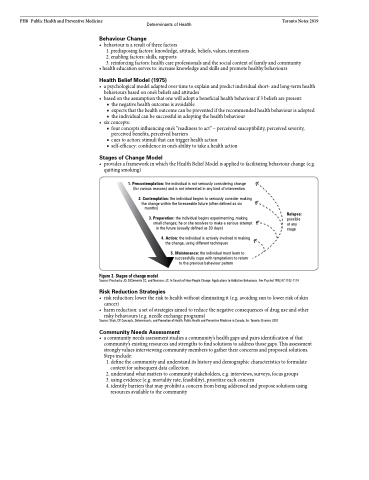Page 1226 - TNFlipTest
P. 1226
PH8 Public Health and Preventive Medicine Determinants of Health Toronto Notes 2019
Behaviour Change
• behaviourisaresultofthreefactors
1. predisposing factors: knowledge, attitude, beliefs, values, intentions
2. enabling factors: skills, supports
3. reinforcing factors: health care professionals and the social context of family and community
• health education serves to: increase knowledge and skills and promote healthy behaviours
Health Belief Model (1975)
• apsychologicalmodeladaptedovertimetoexplainandpredictindividualshort-andlong-termhealth behaviours based on one’s beliefs and attitudes
• basedontheassumptionthatonewilladoptabeneficialhealthbehaviourif3beliefsarepresent:
■ the negative health outcome is avoidable
■ expects that the health outcome can be prevented if the recommended health behaviour is adopted ■ the individual can be successful in adopting the health behaviour
• sixconcepts:
■ four concepts influencing one’s “readiness to act” – perceived susceptibility, perceived severity,
perceived benefits, perceived barriers
■ cues to action: stimuli that can trigger health action
■ self-efficacy: confidence in one’s ability to take a health action
Stages of Change Model
• providesaframeworkinwhichtheHealthBeliefModelisappliedtofacilitatingbehaviourchange(e.g. quitting smoking)
1. Precontemplation: the individual is not seriously considering change (for various reasons) and is not interested in any kind of intervention
2. Contemplation: the individual begins to seriously consider making the change within the foreseeable future (often defined as six
months)
3. Preparation: the individual begins experimenting, making small changes; he or she resolves to make a serious attempt
in the future (usually defined as 30 days)
4. Action: the individual is actively involved in making the change, using different techniques
5. Maintenance: the individual must learn to successfully cope with temptations to return
Relapse:
possible at any stage
to the previous behaviour pattern
Source: Prochaska JO, DiClemente CC, and Norcross JC. In Search of How People Change. Applications to Addictive Behaviours. Am Psychol 1992;47:1102-1114
Risk Reduction Strategies
• riskreduction:lowertherisktohealthwithouteliminatingit(e.g.avoidingsuntolowerriskofskin cancer)
• harmreduction:asetofstrategiesaimedtoreducethenegativeconsequencesofdruguseandother risky behaviours (e.g. needle exchange programs)
Source: Shah, CP. Concepts, Determinants, and Promotion of Health. Public Health and Preventive Medicine in Canada, 5e. Toronto: Elsevier, 2003
Community Needs Assessment
• acommunityneedsassessmentstudiesacommunity’shealthgapsandpairsidentificationofthat community’s existing resources and strengths to find solutions to address those gaps. This assessment strongly values interviewing community members to gather their concerns and proposed solutions. Steps include:
1. define the community and understand its history and demographic characteristics to formulate context for subsequent data collection
2. understand what matters to community stakeholders, e.g. interviews, surveys, focus groups
3. using evidence (e.g. mortality rate, feasibility), prioritize each concern
4. identify barriers that may prohibit a concern from being addressed and propose solutions using
resources available to the community
Figure 3. Stages of change model


